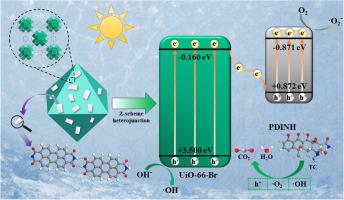配体功能化UiO-66-X(X=H,NH2,Br)/PDINH光催化降解四环素复合材料的制备
IF 5.7
3区 材料科学
Q2 MATERIALS SCIENCE, MULTIDISCIPLINARY
引用次数: 0
摘要
本研究采用酸催化胺化和水热法制备了UiO-66-X(X=H,NH2,Br)/PDINH异质结纳米复合材料。为了研究配体修饰对催化剂性能的影响。选择四环素(0.01 g/L)作为目标污染物,通过控制变量法比较了0.3 g/L模拟太阳光下不同材料对四环素的降解效果。所有复合材料的性能均优于单体。其中UiO-66- br /PDINH的光降解效率最高(97.8%),优于UiO-66/PDINH和UiO-66- nh2 /PDINH。这种良好的光催化活性主要归功于两个方面:(1)z型异质结的构建有利于促进光生载流子的分离;(2)目标污染物TC分子与UiO-66-Br分子间作用力强,结合更紧密。基于能带理论,阐明了z型异质结的形成机理和TC的光催化降解机理。本文章由计算机程序翻译,如有差异,请以英文原文为准。

Preparation of ligand-functionalized UiO-66-X(X=H,NH2,Br)/PDINH composites for the photocatalytic degradation of tetracycline
In this study, the heterojunction nanocomposites UiO-66-X(X=H,NH2,Br)/PDINH were prepared by acid-catalyzed amination and hydrothermal methods. In order to investigate the effect of ligand modification on the performance of the catalyst. Tetracycline (0.01 g/L) was chosen as the target pollutant, and the degradation effect of tetracycline by different materials at 0.3 g/L under simulated sun light was compared by the controlled variable method. All composites showed better performances compared to the monomers. Among them, UiO-66-Br/PDINH showed the highest photodegradation efficiency (97.8 %), which was superior to the UiO-66/PDINH and UiO-66-NH2/PDINH. This good photocatalytic activity is mainly attributed to two aspects: (1) The construction of Z-scheme heterojunction was conducive to promoting the separation of photogenerated carriers; (2) The target contaminant TC molecules and UiO-66-Br had strong intermolecular forces and were more tightly bound. Based on the energy band theory, the formation mechanism of Z-scheme heterojunction and photocatalytic degradation mechanism of TC were elucidated.
求助全文
通过发布文献求助,成功后即可免费获取论文全文。
去求助
来源期刊

Materials Research Bulletin
工程技术-材料科学:综合
CiteScore
9.80
自引率
5.60%
发文量
372
审稿时长
42 days
期刊介绍:
Materials Research Bulletin is an international journal reporting high-impact research on processing-structure-property relationships in functional materials and nanomaterials with interesting electronic, magnetic, optical, thermal, mechanical or catalytic properties. Papers purely on thermodynamics or theoretical calculations (e.g., density functional theory) do not fall within the scope of the journal unless they also demonstrate a clear link to physical properties. Topics covered include functional materials (e.g., dielectrics, pyroelectrics, piezoelectrics, ferroelectrics, relaxors, thermoelectrics, etc.); electrochemistry and solid-state ionics (e.g., photovoltaics, batteries, sensors, and fuel cells); nanomaterials, graphene, and nanocomposites; luminescence and photocatalysis; crystal-structure and defect-structure analysis; novel electronics; non-crystalline solids; flexible electronics; protein-material interactions; and polymeric ion-exchange membranes.
 求助内容:
求助内容: 应助结果提醒方式:
应助结果提醒方式:


